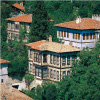 Little Brief About Safranbolu
Little Brief About Safranbolu
From the 13th century to the advent of the railway in the early 20th century, Safranbolu was an important caravan station on the main East–West trade route. The Old Mosque, Old Bath and Süleyman Pasha Medrese were built in 1322. During its apogee in the 17th century, Safranbolu's architecture influenced urban development throughout much of the Ottoman Empire.
History of Safranbolu
The site of Safranbolu has been occupied by human settlements since prehistory, as evidenced by rock-cut tombs and a Roman temple in the vicinity. The present settlement developed as a trading centre after the Turkish conquest in the 11th century. In the 13th century it became an important caravan station on the main east-west trade route. Surviving buildings from this early period include the Old Mosque, the Old Bath, and the Medresse of Siileyman Pasha. all built in 1322.
The caravan trade reached its apogee in the 17th century, when the central market was extended to meet the requirements of travellers rather than the local inhabitants. Many buildings survive from this period, including the Cinci Inn with its sixty guest rooms (1640-48), the Kopriilii Mosque (1661), and the Izzet Pasha Mosque (1796), as well as many stores, stables, and baths.
The 19th century saw considerable investment in private estates and a sharp increase in the size of the town. The richer inhabitants donated public buildings, including eighteen fountains, the ~ and Hamadiye mosques, the Ali Baba convent, and the town hospital.
Changes in trading structures and the advent of the railways brought this long period of prosperity to an end in the early 20th century. The town underwent a period of economic deprivation until the building of the Karabiik steelworks, which provided a great deal of employment in the region. Safranbolu residents who went to work at Karabiik preferred to retain their original homes, thus bringing limited economic stability back to the town.
 Little Brief About Safranbolu
Little Brief About Safranbolu